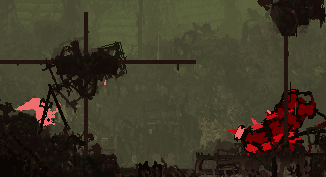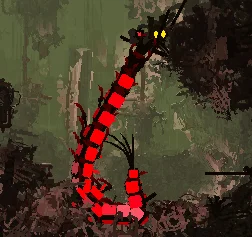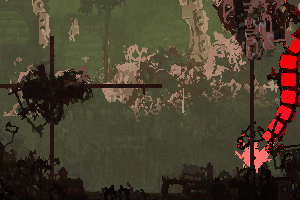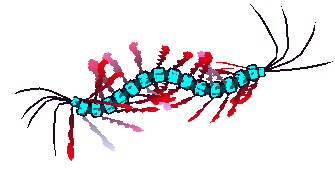
Centipedes are long, segmented myriapods based loosely on their real-world counterparts. Their behavior varies with their size, ranging from passive prey to dangerous predator.
Centipedes have evolved throught time, developing different kind of appendages that allow them to exist and survive in all kind of ecosystems: on the earth, the underground and even the sea and the sky.
Centipedes are black and orange arthropods with protective shells and segmented bodies. They have many legs and 2 sets of feelers on both ends of the body. They have a brown coloration on the ends of their legs, and can range vastly in size.
Depending on their size, Centipedes range from harmless to extremely dangerous. Centipedes are fast crawlers, able to outpace most creatures along the ground, in tunnels, and on poles. Their ability to climb along background walls makes them difficult to evade. Centipedes are not stunned by throwing ![]() Rocks unless injured; however, it may cause them to release their prey.
Rocks unless injured; however, it may cause them to release their prey. ![]() Cherrybombs cause Centipedes to release held creatures, as well as prevent them from grabbing for a short period.
Cherrybombs cause Centipedes to release held creatures, as well as prevent them from grabbing for a short period.
Due to their sharp hearing and vision, sneaking around Centipedes can pose a challenge. Avoid making loud noises or passing by one of their heads to avoid detection. Crouching and crawling greatly reduces their vision. When a Centipede is moving, its vision is further reduced, giving opportunity to sneak past.
Keeping a distance from Centipedes is safest, as they are primarily found in dark, tunnel-filled areas with little room for escape. By use of shortcuts or avoiding areas they are in altogether, it is possible to pass by unharmed. Throwing Rocks or Spears to create sound can lure Centipedes to a different location if there is no other way around. Movement such as slidepouncing, backflipping, and slide flipping can help to keep distance between Slugcat and Centipedes.
Centipedes grab on to creatures with their heads. If they manage to connect both ends to the creature, they deliver a shock. Centipede shocks do not deal damage, but either stun or kill depending on the mass of the creature in relation to the Centipede. If the creature has less mass than the Centipede, the shock kills them. Shocks delivered underwater deal damage instead of depending on mass. The current travels to all other creatures within the same body of water. When injured and attempting to retreat inside a den, Centipedes can latch on to creatures and pull them into the den, killing them.
Centipedes have strongly movement-based vision. All Centipedes share the same vision capabilities regardless of size. They are only able to see out of 1 head at a time, but alternate between heads every frame. Centipedes' alternating vision causes a unique behavior; as long as ![]() Slugcat moves at a steady pace across flat terrain, or when climbing poles, Centipedes are caught in a consistent loop of starting and stopping. This behavior is caused by their alternating vision, where they have to re-realize that Slugcat is moving. This loop can be used to escape a Centipede safely, as they do not grab on to Slugcat unless provoked or run into.
Slugcat moves at a steady pace across flat terrain, or when climbing poles, Centipedes are caught in a consistent loop of starting and stopping. This behavior is caused by their alternating vision, where they have to re-realize that Slugcat is moving. This loop can be used to escape a Centipede safely, as they do not grab on to Slugcat unless provoked or run into.
Centipedes cannot see Slugcat when they are crouching and have greatly reduced vision when crawling. If a Centipede is moving, their vision is further reduced, and they become unable to see Slugcat when crawling or standing.
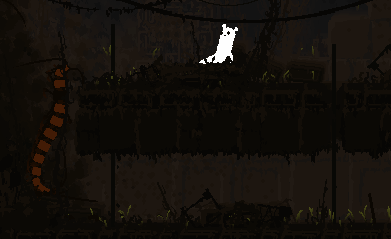
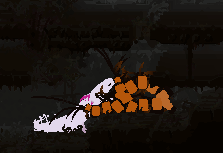
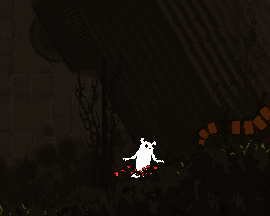
Centiwings are a flying Centipede variant found primarily in ![]() Sky Islands. They are characterized by their green color, ability to fly, and somewhat skittish behavior.
Sky Islands. They are characterized by their green color, ability to fly, and somewhat skittish behavior.
Centiwings are long, black arthropods with segmented bodies and bright green protective shells. They have many legs which have a dark green coloration on their ends. Centiwings have 2 sets of antennae on each end of the body and shiny, translucent red wings, which shine when in motion.
Centiwings are initially afraid of creatures until they have been in their presence for a period of time. Due to their flight, they are able to outpace most creatures once they become aggressive. Like other Centipedes, Centiwings are not stunned by Rocks unless injured; however, they always drop held creatures when hit. Centiwings are also stunned for twice as long as other Centipedes. Despite being unable to hear, Centiwings still drop creatures and flee when a ![]() Cherrybomb is thrown.
Cherrybomb is thrown.
Centiwings can be killed with 3-4 Spears, though less are needed to make one flee. When severely injured, Centiwings begin to spasm and attempt to return to their dens.
Like other arthropods, ![]() Spore Puffs can be used to dispatch them; this is especially effective with Centiwings, as their flying patterns commonly curl them up, allowing the Spore Puff's cloud to engulf more of their body.
Spore Puffs can be used to dispatch them; this is especially effective with Centiwings, as their flying patterns commonly curl them up, allowing the Spore Puff's cloud to engulf more of their body.
Centiwings are almost always moving and can traverse rooms in a short period of time, potentially allowing them to find Slugcat easily. However, Centiwings cannot see very far and are incapable of hearing. Crouching and crawling reduces their vision further. Moving swiftly can help to avoid detection, as well as seeking cover beneath level geometry or within tunnels.
Centiwings are initially fearful of Slugcat and do not attack them until a period of time has passed; the player can take advantage of this short window to pass through rooms without risk. Centiwings are normally found flying through the upper areas of a room, so taking a lower path can help to avoid them.
Centiwings grab on to creatures by their heads. If they manage to latch on with both ends of their bodies, they deliver a shock. Rather than dealing a set amount of damage, Centiwing shocks either kill or stun the creature depending on their mass in relation to the Centiwing. If they weigh less than the Centiwing, they die. When injured and attempting to retreat to a den, Centiwings can latch on to creatures and pull them inside of the den, killing them.
Centiwings have a unique timer for determining aggression. Upon seeing a creature, they start a countdown in which they consider the creature a threat for 7.5 seconds. They become progressively less afraid as the timer ticks down, and once it reaches 0, they grow progressively more aggressive towards the creature. Once they consider a creature prey, they begin pursuing and attempting to kill them. Every creature has their own individual timer once noticed. These timers can run simultaneously and do not interrupt each other. This timer is paused if the Centiwing is stunned but resumes shortly after.
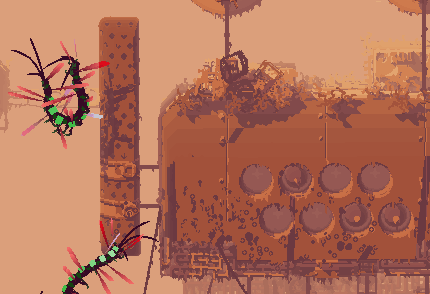
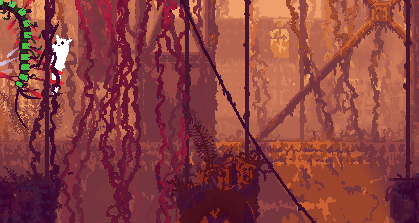
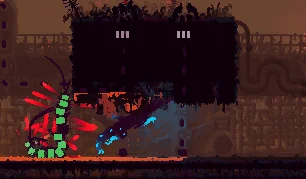
Aquapedes are large, aquatic Centipedes that are primarily encountered in the lowermost areas of ![]() Shoreline and in
Shoreline and in ![]() Submerged Superstructure. They are incapable of leaving the water, but their speed and aggression makes them adept at taking down prey.
Submerged Superstructure. They are incapable of leaving the water, but their speed and aggression makes them adept at taking down prey.
Aquapedes are large blue and black aquatic arthropods with protective shells and segmented bodies. Their shells are dappled with dark spots. They have four antennae on each end of the body, and do not have any legs. Aquapedes have long, tattered red frills similar to those of Centiwings, which shine when in motion. Aquapedes can emit a bright glow from their heads.
Aquapedes pose a significant threat in underwater areas, especially in tight spaces, where movement can be difficult. Fighting an Aquapede underwater is tricky, as objects like ![]() Spears and
Spears and ![]() Rocks lose their speed quickly. This combined with the Aquapede's high agility makes engaging the creature typically fruitless.
Rocks lose their speed quickly. This combined with the Aquapede's high agility makes engaging the creature typically fruitless.
However, unlike other Centipedes, Aquapedes are stunned by Rocks when uninjured. ![]() Cherrybombs cause Aquapedes to drop held creatures and prevent them from grabbing for a short period.
Cherrybombs cause Aquapedes to drop held creatures and prevent them from grabbing for a short period.
Aquapedes can be killed with 2-7 Spear hits, depending on their size. Segments that have been de-shelled take extra damage. Like other arthropods, they can be killed with ![]() Spore Puffs.
Spore Puffs.
Sneaking around Aquapedes is an almost impossible endeavor, as they are located in areas where treading water is required. Their sharp underwater vision means Slugcat is almost always detected. Taking tunnels or paths out of their line of sight, whenever possible, can help avoid detection. Alternatively, creatures such as ![]() Jetfish can provide a distraction.
Jetfish can provide a distraction.
While Aquapedes are quick underwater, they have trouble pursuing prey in a straight line. Making frequent turns or dives can help evade a pursuing Aquapede. Jetfish can be used to outpace Aquapedes. Jetfish can also be run into Aquapedes, stunning them temporarily.
Like other Centipedes, Aquapedes can grab on to creatures using their heads. If they manage to connect both ends to the creature, they deliver a lethal shock. Because Aquapedes are located in water, their shocks almost always do damage instead of relying on weight relation. Their underwater shocks deal 1 damage per frame. This shock has a radius that affects other creatures in the same body of water. However, because an Aquapede's shock radius would be too large, it is clamped to a smaller radius of 80 pixels, or 4 tiles. Aquapedes can deliver shocks in rapid succession to creatures with more health.
Aquapedes possess the ability to swim and dive underwater to pursue prey. Their swimming speed greatly outpaces most ![]() Slugcats. Aquapedes wiggle when swimming, similarly to Centiwings in flight. Their proficiency underwater can be impeded by making sharp turns, as it can disturb the flow of the Aquapede, allowing for evasion.
Slugcats. Aquapedes wiggle when swimming, similarly to Centiwings in flight. Their proficiency underwater can be impeded by making sharp turns, as it can disturb the flow of the Aquapede, allowing for evasion.
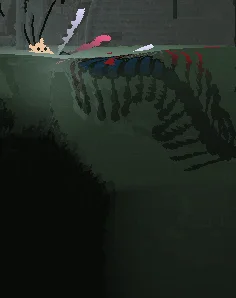
Red Centipedes are a variant of Centipede characterized by their large size and bright red coloration. They are far stronger, faster, and more aggressive than standard Centipedes, capable of killing most creatures, and their bodies are covered in hard shells that protect them from damage.
Red Centipedes are only found naturally in a few locations for ![]() Hunter and in the rest of the expansion campaigns. They do not spawn natively while playing as
Hunter and in the rest of the expansion campaigns. They do not spawn natively while playing as ![]() Monk or
Monk or ![]() Survivor and can only be encountered through the lineage system during these campaigns.
Survivor and can only be encountered through the lineage system during these campaigns.
Red Centipedes are long, black and red, arthropod-like creatures with 18-segmented bodies covered by hard, protective shells. Each segment has 4 shells, and each top shell has a protruding spike. They have many legs and 2 sets of antennae on both ends of the body.
Due to their shelled segments and fast, aggressive behavior, Red Centipedes pose a large threat in close-quarters combat. Before a segment can be damaged, its shell must first be removed, most easily by use of Spears. While most Slugcats are able to immediately de-shell a segment with a ![]() Spear, Monk only has a 1/3 chance to de-shell a segment if there are at least 10 shells remaining and 1/20 otherwise. Red Centipedes barely flinch when a shelled segment is hit, allowing them to quickly home in on their target. Once their shells have been removed, Red Centipedes are vulnerable to stunning via Spears or
Spear, Monk only has a 1/3 chance to de-shell a segment if there are at least 10 shells remaining and 1/20 otherwise. Red Centipedes barely flinch when a shelled segment is hit, allowing them to quickly home in on their target. Once their shells have been removed, Red Centipedes are vulnerable to stunning via Spears or ![]() Rocks.
Rocks.
Red Centipedes take extra damage from explosives if they hit a de-shelled segment, making Explosive Spears and Grenades helpful. ![]() Cherrybombs startle them, preventing them from grabbing for a short duration and causing them to let go of held creatures.
Cherrybombs startle them, preventing them from grabbing for a short duration and causing them to let go of held creatures.
As with all other arthropod-like creatures, Red Centipedes are extremely vulnerable to ![]() Spore Puffs. A single Spore Puff is capable of killing a Red Centipede, provided it hits enough segments.
Spore Puffs. A single Spore Puff is capable of killing a Red Centipede, provided it hits enough segments.
Sneaking around Red Centipedes can be challenging, as their sharp hearing and vision makes it easy for them to pinpoint creatures. Moving silently or avoiding passing by their heads can prevent detection. Their vision is significantly reduced by crouching and crawling. They cannot see Slugcat when in an idle crouch, or when idle on poles and in tunnels. However, once they have noticed their prey, they are difficult to distract.
It is safest to keep a long distance from Red Centipedes, as they are fast enough to outpace Slugcat. Due to their rarity, it is normally possible to avoid them by taking an alternative route. Throwing Rocks or Spears to create sound can lure Red Centipedes to a different location if there is no other way around. Advanced movement such as slidepouncing can put distance between Slugcat and Red Centipedes.
Red Centipedes can grab on to creatures by their heads. If they connect both heads, they deliver a shock that can kill most creatures. A creature shocked by a Red Centipede is either killed or stunned depending on its mass, with the exception of Train Lizards which are completely immune to Red Centipede shocks. Red Centipedes may shock multiple times. When injured and near their den, Red Centipedes can latch on to creatures and pull them into the den, killing them.
When shocking underwater, Red Centipede's shocks deal damage, allowing them to kill creatures that would otherwise be stunned. Underwater shocks travel to all other creatures in the same body of water.
Red Centipedes have movement-based vision. Their vision greatly improves when a creature moves nearby. Red Centipede's vision worsens when they move. They are only able to see out of one head at a time, but alternate between heads every frame.
